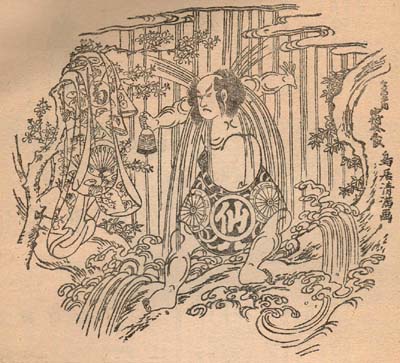| NAKAMURA SUKEGORď I |
|
Stage names:
Guild: Sengokuya Line number: SHODAI (I) Poetry name: Gyoraku Existence: 1711 ~ 13th day of the 7th lunar month of 1763 [1] Connection: Father: Sengoku Hikosuke I Master: Nakamura Shichisabur˘ II Son: Nakamura Sukegor˘ II Career: 1711: born in Edo. His father, the d˘kegata actor Sengoku Hikosuke I, gave him the name of Sengoku Kametar˘. 11th lunar month of 1724: he became wakashugata iroko at the Moritaza. 11th lunar month of 1725: he became disciple of Nakamura Shichisabur˘ II and received the name of Nakamura Kametar˘. 11th lunar month of 1735: he became tachiyaku and took the name of Band˘ Sukegor˘ at the Kawarasakiza, performing in the kaomise drama "Banzei Ikioi Izu Nikki". 11th lunar month of 1736: he took the name of Nakamura Sukegor˘ I at the Kawarasakiza, performing in the kaomise drama "Junpű Taiheiki". 11th lunar month of 1737: he took the name of Sengoku Sukegor˘ at the Kawarasakiza, performing in the kaomise drama "Urűzuki Ninin Kagekiyo". 11th lunar month of 1739: he took back the name of Nakamura Sukegor˘ I at the Nakamuraza, performing in the kaomise drama "Miyakozome Kaoru Hachinoki". 26th day of the 4th lunar month of 1740 [3]: his father Sengoku Hikosuke I died. Janvier 1742: Sukegor˘ played at the Nakamuraza the role of ďmi no Gengo in the new year drama "Musume Soga Gaijin Yashima". 1st lunar month of 1746: Sukegor˘'s rank in the Edo hy˘banki, katakiyaku section, was j˘-j˘-(shiro)kichi (superior - superior - (white) excellent) [visual]. 3rd lunar month of 1747: the play "Sugawara Denju Tenarai Kagami" was performed for the first time in Edo, at the Ichimuraza; Sukegor˘ played the role of Matsu˘maru [casting]; his stage partner in the role of Matsu˘maru's wife Chiyo was Segawa Kikujir˘ I. 11th lunar month of 1749: Sukegor˘ achieved a great success at the Ichimuraza by playing the roles of ďmi no Kot˘ta and Matano Gor˘ in the kaomise drama "Yoritomo Gunbai Kagami", which celebrated the arrival in Edo of the actor Nakamura Kiyosabur˘ I. 1st lunar month of 1752: Sukegor˘ played at the Nakamuraza the role of Ky˘ no Jir˘ in the new year sogamono "Kuruwa Kuruwa Akinai Soga". Sukegor˘ also played the role of the ďshű otokodate Teppeki Sh˘hei in the drama "Hana Sugata Sanpukutsui" (the nibanme of "Kuruwa Kuruwa Akinai Soga"), sharing the stage with Fujikawa Heikur˘ (the Naniwa otokodate Akaushi Yasubŕ) and Matsumoto K˘shir˘ II (the Azuma otokodate Banzuiin Ch˘bŕ) [print]. 7th lunar month of 1752: Sukegor˘ played in the same theater the role of the rebel Abe no Munet˘ in the drama "Moro Tazuna ďshű Kuro"; the role of Abe no Sadat˘ (Munet˘'s brother) was played by Matsumoto K˘shir˘ II. 7th lunar month of 1754: Sukegor˘ played at the Nakamuraza the role of Matsunaga Danj˘ in the drama "Kongen Okuni Kabuki"; his stage partners in the roles of ďmi no Okane, Umetada Tokubŕ and Yamamoto Kansuke were Nakamura Tomijűr˘ I, ďtani Hiroji II and Ichikawa Ebiz˘ II. 11th lunar month of 1754: Sukegor˘ played at the Nakamuraza the role of the ashigaru Kanbei (in reality Oni˘ Shinzaemon) in the kaomise drama "Miura no ďsuke Bumon no Kotobuki", which celebrated the shűmei of Ichikawa Danjűr˘ IV, Matsumoto K˘shir˘ III and Tsuuchi Monzabur˘ II. 1st lunar month of 1755: Sukegor˘ played in the same theater the roles of Wat˘nai and ďtsu Jir˘ in the new year sogamono drama "Waka Midori Nishiki Soga". 11th lunar month of 1762: Sukegor˘ played at the Moritaza in the kaomise drama "T˘zai T˘zai Wagakuni no Umeyashiki"; he was the zagashira of the new troupe at the Moritaza. 2nd lunar month of 1763: first Kabuki adaptation of the puppet theater drama "ďshű Adachi-ga-Hara", which was staged at the Moritaza; Sukegor˘ played the roles of Abe no Munet˘ and Iwate [casting|illustrations]. He also performed in the dance "Ishidatami Wakaba Zakura", which commemorated the memory of late Sanogawa Ichimatsu I, who suddenly died the 12th of the 11th lunar month of 1762 [4]. Sukegor˘ was in tears from the beginning to the end of his performance, expressing from the depths of his heart a tearful remorse [2]. This was also the last stage appearance of Sukegor˘, who fell ill. 13th day of the 7th lunar month of 1763 [1]: Sukegor˘ died in Edo. Comments: Nakamura Sukegor˘ I was an outstanding tachiyaku and katakiyaku actor, who made a great career in Edo from the Genbun era to the H˘reki era. He excelled in jitsuaku and sum˘tori roles. His performances in duo with ďtani Hiroji II were very popular. His best level in the Edo hy˘banki was j˘-j˘-kichi (superior - superior - excellent) [visual]. [1] The 13th day of the 7th lunar month of the 13th year of the H˘reki era was the 21st of August 1763 in the western calendar. [2] Sukegor˘ had a quarrel with the late actor a few weeks before his death. Things settled down and Sanogawa Ichimatsu I agreed to take part in the same kaomise as Sukegor˘. He suddenly died before the beginning of this program. [3] The 26th day of the 4th lunar month of the 5th year of the Genbun era was the 21st of May 1740 in the western calendar. [4] The 12th day of the 11th lunar month of the 12th year of the H˘reki era was the 26th of December 1762 in the western calendar. |
 |
|
Nakamura Sukegor˘ I performing in the drama "Na no Hana Sumidagawa", which was staged in the 3rd lunar month of 1759 at the Moritaza The Nakamura Sukegor˘ line of actors |
|
|
| Contact | Main | Top | Updates | Actors | Plays | Playwrights | Programs | Links | FAQ | Glossary | Chronology | Illustrations | Prints | Characters | Derivatives | Theaters | Coming soon | News |